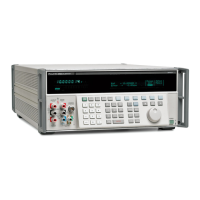5700A/5720A Series II
Operators Manual
5-8
5-9. Parameter Syntax Rules
Many of the remote commands require parameters, which must be used properly to avoid
command errors. When a command error occurs, bit CME (5) in the Event Status Enable
Register (ESE) goes to 1. General rules for parameter usage are:
1. When a command has more than one parameter, the parameters must be separated by
commas. For example: “OUT 1 V, 100 HZ.”
2. Numeric parameters may have up to 255 significant figures and their exponents may
range from -32000 to +32000. The useful range for calibrator programming is ± 2.2
E-308 to ± 1.8 E308.
3. Including too many parameters causes a command error.
4. Null parameters cause a command error (e.g., the adjacent commas in “CLOCK
133700, , 071787”).
5. Expressions, for example “(4+2*13)”, are not allowed as parameters.
Units accepted in command parameters and used in responses are:
• HZ (frequency, hertz)
• MHZ (frequency, megahertz)
• V (voltage, volts)
• A (current, amperes)
• OHM (resistance, ohms)
• MOHM (resistance, megohms)
• DB (decibels)
• DBM (decibels referenced to 1 milliwatt for ac voltage amplitude)
• PCT (percent)
• PPM (parts per million)
Multipliers accepted in command parameters are:
• MA (mega, or unit x 1,000,000)
• K (kilo, or unit x 1,000)
• M (milli, or unit /1,000; except MOHM and MHZ)
• U (micro, or unit /1,000,000)
Some examples of allowed unit and multiplier combinations are:
• “MOHM” and “MAOHM” are both interpreted as megohms
• “MHZ”and “MAHZ” are both interpreted as megahertz
• “MV” is interpreted as millivolts
• “MAV” is interpreted as megavolts
• “MA” is interpreted as milliamperes

